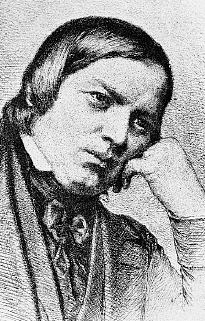Biography
Robert Schumann (1810–1856)

Robert Schumann’s father, a bookseller and writer, encouraged the boy’s musical talent and started him studying the piano at the age of six. When his father died, his mother wanted him to go into law; he attended the University of Leipzig, but finally persuaded her to let him pursue the career of a piano virtuoso. He had to give this up, however, after an injury sustained when he tried to strengthen his fingers with a mechanical device.
Besides his musical talent, Schumann had a great flair for literature, no doubt inherited from his father. When he was only twenty-
Schumann’s piano works — among his most important music — are mostly “character pieces,” often with imaginative titles, and occasionally signed “Eu.” or “Fl.” at the end. They are arranged in loosely organized sets, with titles such as Butterflies, Scenes from Childhood, and Carnaval.
Schumann fell in love with Clara Wieck, the daughter of his piano teacher; at the age of fifteen she was already a famous pianist. Thanks to her father’s fanatical opposition — he did not think Robert was a very savory character — they had to wait until she was twenty-
A little later, he also turned to the composition of larger works: concertos, symphonies, chamber music, choral music, and one opera. Thereafter he worked as a teacher and conductor, but his withdrawn personality made him less than successful. Schumann suffered from mood swings and had experienced breakdowns in his youth, and now he began to show tragic signs of insanity. In 1854, tormented by voices, hallucinations, and loss of memory, he tried to drown himself in the river Rhine and was committed to an asylum. He died two years later.
Chief Works: Sets of miniatures for piano, among them Scenes from Childhood, Album for the Young, Papillons (Butterflies), and Carnaval ◼ Songs (lieder) and song cycles: Woman’s Life and Love, Dichterliebe ◼ Piano Fantasy (a free sonata); Piano Concerto and the first important concerto for cello; four symphonies ◼ Chamber music: a quintet and a quartet for piano and strings ◼ An opera, Genoveva; incidental music to Byron’s Manfred and Goethe’s Faust; choral works
Encore: After Dichterliebe and Carnaval, listen to the Piano Concerto in A Minor.
Image credit: Bettmann/CORBIS.